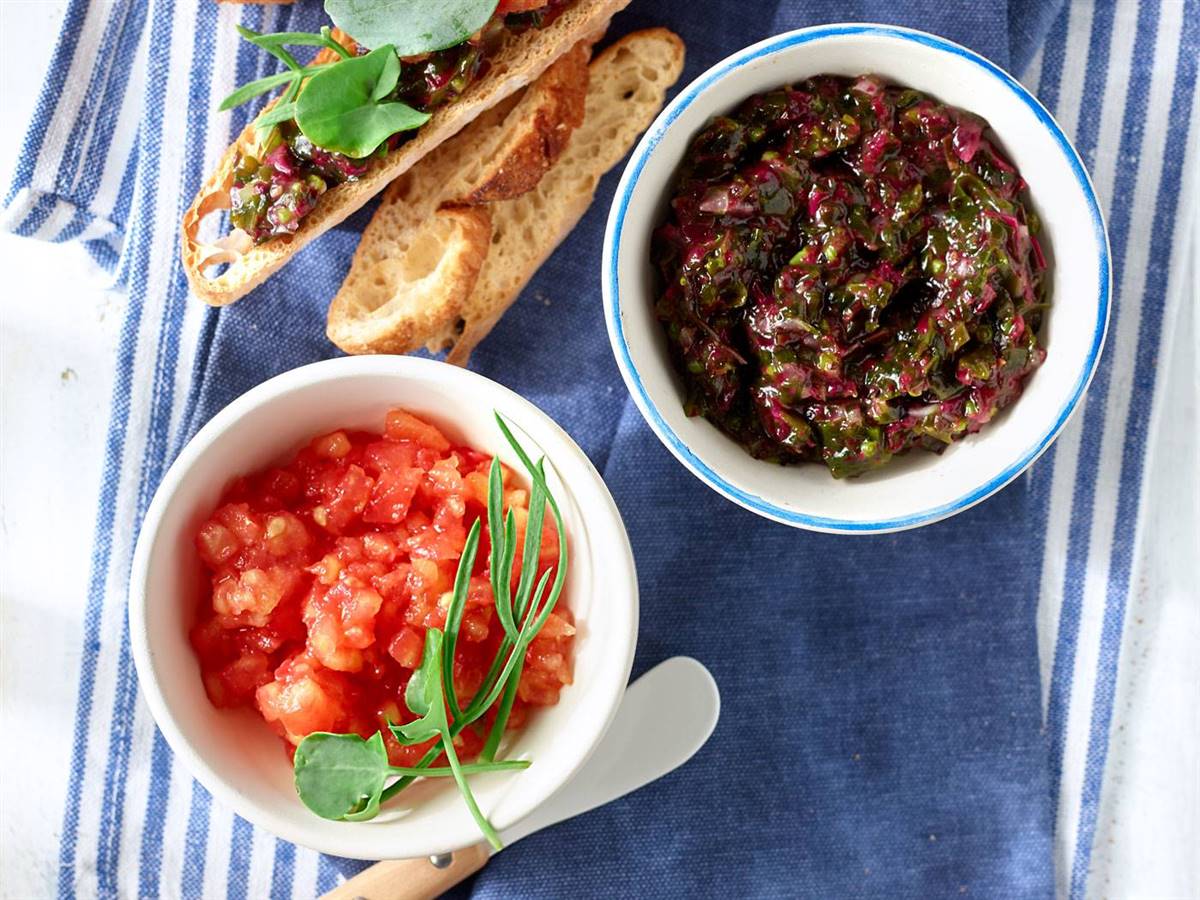Seaweed is a great ally in the kitchen. With little, we give an unmistakable marine touch to the dishes and increase the contribution of minerals and antioxidants. We show you 5 recipes with seaweed to lick your fingers.

Due to its variety of textures, flavors, colors and nutrients, seaweed is very easy to combine in any dish. However, the recipes with seaweed that we show you below stand out for being especially tasty and original proposals.
What seaweed is usually included in dishes? The seaweeds that are most consumed and used in the culinary field are sea spaghetti, sea lettuce, wakame, dulse, nori, kombu, hijiki and agar, although the latter is not an alga in itself, but a set of parts of different seaweed that are rich in dietary fibers and are used to make vegetable jellies.
SEAWEED TARTARE WITH MARINATED TOMATO
Ingredients for 4 people:
For the tomato:
- 4 ripe tomatoes
- 1 chilli pepper
- 1 garlic clove
- a few basils leaves
- medium small zucchini
- virgin olive oil
- salt
For the algae
- 10 grams of dehydrated assorted seaweed (wakame flakes, dulse, hiziki)
- 1 spring onion
- a few sprigs of salicornia
- 50 ml apple cider vinegar
- 2 tablespoons smoked oil
- sea fennel on the side
- acerola to accompany
Preparation (40 minutes + resting time):
- Wash, peel the tomatoes and chop them. Put them in a colander with the crushed garlic clove, chilli and basil leaves, salt and let stand for 2 hours.
- Once this time has elapsed, place them in a bowl, add 3 tablespoons of oil, the chopped zucchini, stir and set aside.
- To prepare the seaweed tartare, first peel and chop the spring onion, put it in a bowl with vinegar, stir and leave to marinate for 30 minutes.
- Soak the seaweed for 1 hour, drain and chop with the salicornia. Add the drained spring onion and continue chopping.
- Season with the smoked oil and mix well.
- When serving, divide the tomato and tartare, and serve with the sea fennel and acerola.
GREEN SOUP WITH SEA LETTUCE
Ingredients for 4 people:
- 40 g fresh sea lettuce
- 10 g fresh Irish moss
- 2 cucumbers
- 1 avocado
- 1 garlic clove
- 1 green bell pepper
- 100 g spinach sprouts
- a few basils leaves
- 50 g crumbled walnuts
- 50 ml virgin olive oil
- 1 tablespoon apple cider vinegar
- salt
Preparation (20 minutes):
- Rinse the algae thoroughly.
- Wash the vegetables, peel the cucumbers, avocado and garlic. Also, the pepper, removing the seeds and veins.
- Chop the vegetables and place them in the blender along with the spinach, avocado, basil leaves, three-quarters of the sea lettuce, a pinch of salt, olive oil and vinegar.
- Blend everything until you get a fine texture, pass it through a sieve and add water if you want a more liquid texture.
- To serve, accompany the crumbled walnut soup and the rest of the seaweed.
NERONE RICE BALLS WITH ARAME AND VEGETABLES
Ingredients for 4 people:
- 1 cup nerone rice
- 10 g arame
- 1 carrot
- half zucchini
- 1 spring onion
- 50 g capers, drained
- chopped basil leaves
- 1 tablespoon freshly ground chia
- 20 g nutritional yeast
- 50 g peeled hemp
- 100 g breadcrumbs
- virgin olive oil and salt
- For the tomato sauce
- 1 kg plum tomatoes
- half onion
- 4 garlic cloves
- 2 jalapeños and a pinch of chili pepper
- 2 sprigs of fresh basil
- 1 teaspoon cumin powder
- half a teaspoon oregano
- 2 tablespoons lemon juice
- Nutritional yeast
- 2 tablespoons sauerkraut juice
Preparation (120 min + fermentation and resting):
- Blanch and peel the tomato, and chop it along with the onion, jalapeño, garlic and basil.
- Add the spices, lemon and sauerkraut liquid.
- Place everything in a two-litre wide-mouth jar and cover with a ziplock bag filled with water to press down on the sauce. Leave to ferment at room temperature for 3 days and then transfer to the fridge.
- To prepare the balls, wash the rice and boil it in plenty of water for 45 minutes.
- Rehydrate the seaweed for 10 minutes and add it halfway through cooking.
- Once the rice is cooked, strain it and, in a bowl, add the chia.
- Wash and chop the vegetables. Sauté the carrot and spring onion in oil for 5 minutes over low heat, add the zucchini and leave for 2 more minutes. Allow to cool.
- Add the stir-fry, capers and basil to the rice. Season with salt and chill for 2 hours in the fridge.
- Form the rice balls, coat them with the mixture of breadcrumbs, yeast and hemp. Fry in plenty of oil and serve with the sauce.
VEGETABLE PAELLA WITH SEA SPAGHETTI
Ingredients for 4 people:
- 200 g bomba rice
- 2 ripe tomatoes
- 100 g fine green beans
- half a red pepper
- half green pepper
- half aubergine
- 1 pepper
- 1 head of garlic
- 40 g fresh sea spaghetti
- a few strands of saffron
- extra virgin olive oil
- salt
Preparation (50 min):
- Wash the rice several times and drain it. Rinse the sea spaghetti thoroughly and chop it.
- Wash all the vegetables and prepare them: grate the flesh of the tomatoes; Peel the garlic and make a cut without splitting it; remove the seeds to the ñora; and chop the rest of the vegetables.
- In a paella pan with 100 ml of oil, gently fry the ñora until it is slightly golden. Once cool, put it in a mortar and pestle with a little salt and chop it.
- In that oil, add the peppers and cook them for 5 minutes; Add the tomato, garlic head and saffron and cook until all the water evaporates.
- Add the rice, and stir for a few minutes until slightly browned.
- Pour 1 litre of hot water with the ñora, increase the heat and add the rest of the vegetables and sea spaghetti.
- Cook over high heat for 15 minutes, lower it to low and cook for 5 more minutes, until dry.
- Let the rice sit for a few minutes and serve.
LIME, JASMINE AND SPEARMINT JELLY
Ingredients for 4 people:
- 1 kg apples
- 3 limes
- a few fresh mints leaves
- 1 teaspoon agar
- 2 tablespoons agave syrup
- 1 cup jasmine flowers
Preparation (30 min + draining time):
- Wash the apples well under the tap if they are not organic, clean them and cut them into quarters. Wash the lime and cut it evenly.
- Place both the apple and lime in a pot and add a glass of filtered or mineral water.
- Then cook them over low heat along with the two tablespoons of agave syrup until the apples are very tender.
- Once the apples are cooked, drain the contents in a colander for a few hours.
- Place the remaining liquid in a saucepan along with the mint leaves and the teaspoon of agar. Let it boil for 1 minute and, be careful, remove it from the heat immediately.
- Add the jasmine petals, stir to combine, and let cool. You’ve got the jelly.
COOKING WITH SEAWEED
Seaweed is a very nutritious sea vegetable that provides us with minerals, vitamins and antioxidants. They are always used in small doses, but it is interesting to include them with some frequency, especially if you consume foods rich in fiber, such as whole grains and legumes.
Certain algae, especially kombu, help to make fibres more digestible, and even enhance the flavour of food and make it more palatable to the palate.
In addition, they help to compensate for the nutritional deficiencies that occur in terrestrial plants due to soil abuse and unrespectful cultivation and harvesting methods.
THEY GIVE FLAVOR AND MAKE YOUR DISHES HEALTHIER
Seaweed provides minerals such as iron, calcium, phosphorus and iodine. The latter stimulates the thyroid and people with problems derived from this gland should be very cautious with its consumption, and the same goes for those with kidney problems, because the richness and concentration of minerals in the algae can interfere with the treatment they are following.
Seaweed also provides a type of fiber called mucilage, which stimulates the functioning of the large intestine, allowing for good daily elimination of waste. And they contribute to the elimination of purines of animal origin thanks to algenic acid.
At the same time, they help to strengthen the skeleton and have a regulatory action on blood circulation. They stimulate the defenses, and can have analgesic, anti-inflammatory and alkalizing properties, among others.
DON’T GO OVERBOARD WITH THE AMOUNT
Depending on the variety of algae used, the soaking time – when necessary to rehydrate them – varies in each case.
As for the quantity, it is usually enough to use 3 to 5 grams dry, usually and per person. Once hydrated, their volume can increase up to ten times.
HOW TO INCLUDE THEM IN YOUR RECIPES
Once hydrated, we can sauté them or stew them with other vegetables to accompany pasta or rice.
In tempura you get a healthy snack with a marine aroma, and raw you can add them to a salad.
Instead of rehydrating them, they can also be roasted without oil in a pan and ground with a grinder, or purchased ground or flaked, to be used as a condiment for creams, salads or stews, among others. Its introduction into the kitchen only requires a little imagination.
In Eastern countries there is a gastronomic tradition linked to seaweed, and they are still used in many preparations. That variety can also be ours if we bring the aromas of the sea and its benefits to the dishes.








